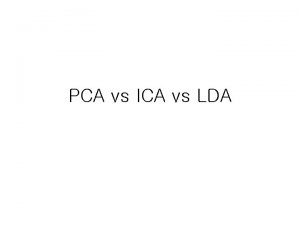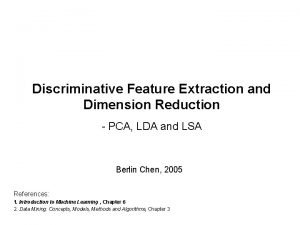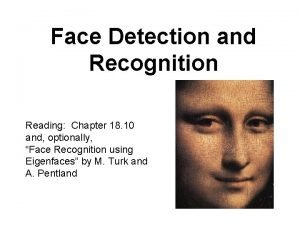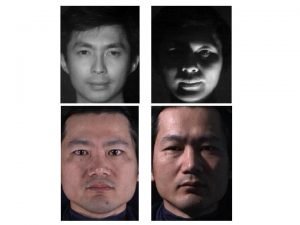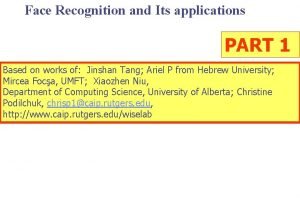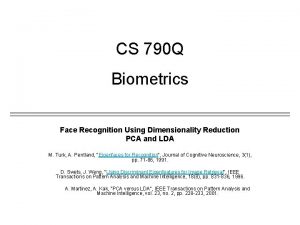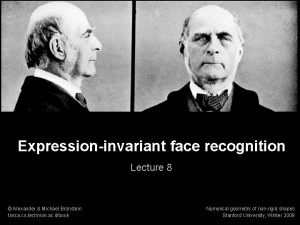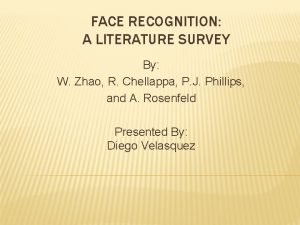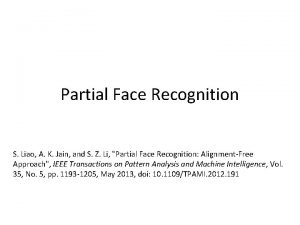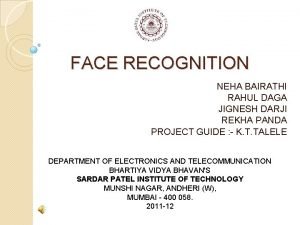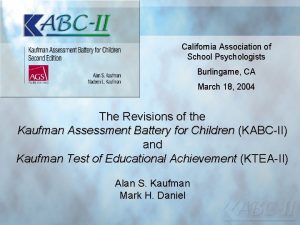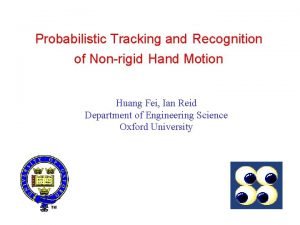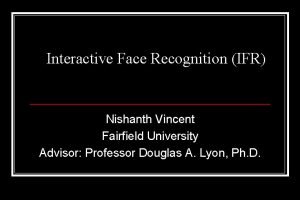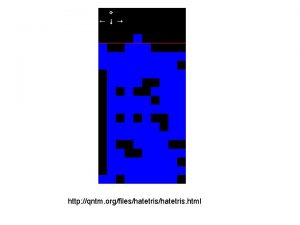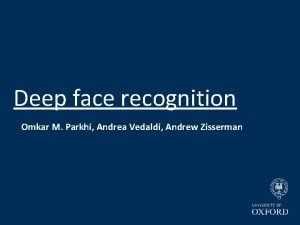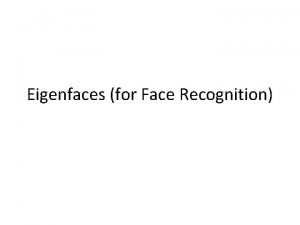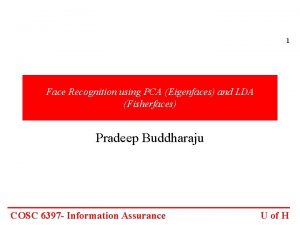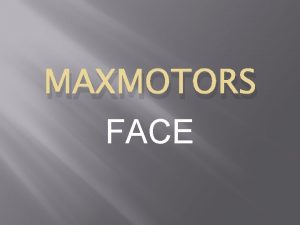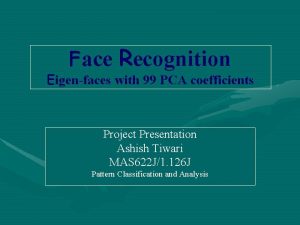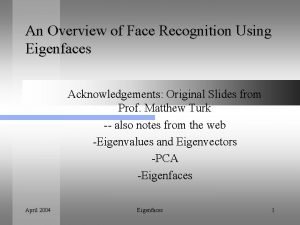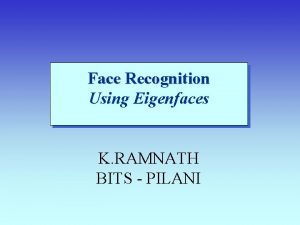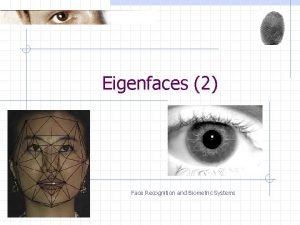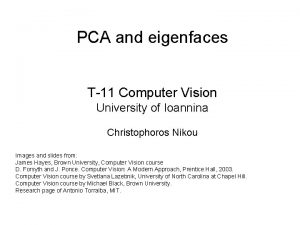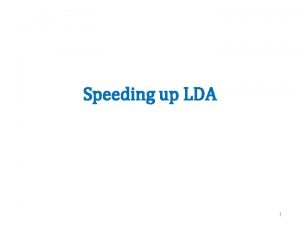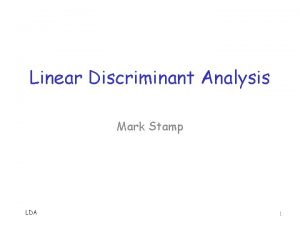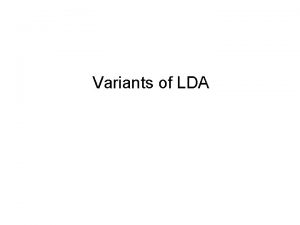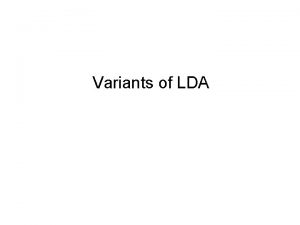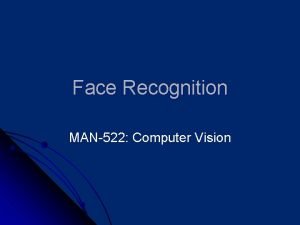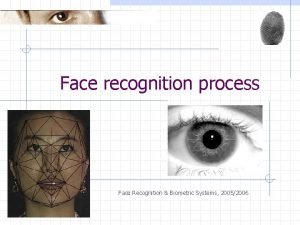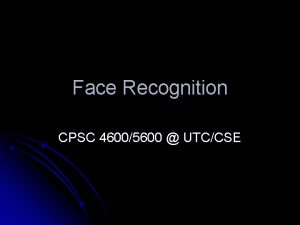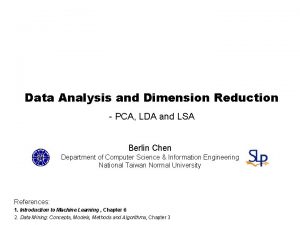Face Recognition using PCA Eigenfaces and LDA Fisherfaces




















- Slides: 20

Face Recognition using PCA (Eigenfaces) and LDA (Fisherfaces) Slides adapted from Pradeep Buddharaju

Principal Component Analysis • A N x N pixel image of a face, represented as a vector occupies a single point in N 2 -dimensional image space. • Images of faces being similar in overall configuration, will not be randomly distributed in this huge image space. • Therefore, they can be described by a low dimensional subspace. • Main idea of PCA for faces: – To find vectors that best account for variation of face images in entire image space. – These vectors are called eigen vectors. – Construct a face space and project the images into this face space (eigenfaces).

Image Representation • Training set of m images of size N*N are represented by vectors of size N 2 x 1, x 2, x 3, …, x. M Example

Average Image and Difference Images • The average training set is defined by = (1/m) ∑mi=1 xi • Each face differs from the average by vector ri = x i –

Covariance Matrix • The covariance matrix is constructed as C = AAT where A=[r 1, …, rm] Size of this matrix is N 2 x N 2 • Finding eigenvectors of N 2 x N 2 matrix is intractable. Hence, use the matrix ATA of size m x m and find eigenvectors of this small matrix.

Eigenvalues and Eigenvectors - Definition • If v is a nonzero vector and λ is a number such that Av = λv, then v is said to be an eigenvector of A with eigenvalue λ. Example

Eigenvectors of Covariance Matrix • The eigenvectors vi of ATA are: • Consider the eigenvectors vi of ATA such that ATAvi = ivi • Premultiplying both sides by A, we have AAT(Avi) = i(Avi)

Face Space • The eigenvectors of covariance matrix are ui = Avi • ui resemble facial images which look ghostly, hence called Eigenfaces

Projection into Face Space • A face image can be projected into this face space by pk = UT(xk – ) where k=1, …, m

Recognition • The test image x is projected into the face space to obtain a vector p: p = UT(x – ) • The distance of p to each face class is defined by Єk 2 = ||p-pk||2; k = 1, …, m • A distance threshold Өc, is half the largest distance between any two face images: Өc = ½ maxj, k {||pj-pk||}; j, k = 1, …, m

Recognition • Find the distance Є between the original image x and its reconstructed image from the eigenface space, xf, Є2 = || x – xf ||2 , where xf = U * x + • Recognition process: – IF Є≥Өc then input image is not a face image; – IF Є<Өc AND Єk≥Өc for all k then input image contains an unknown face; – IF Є<Өc AND Єk*=mink{ Єk} < Өc then input image contains the face of individual k*

Limitations of Eigenfaces Approach • Variations in lighting conditions – Different lighting conditions for enrolment and query. – Bright light causing image saturation. • Differences in pose – Head orientation - 2 D feature distances appear to distort. • Expression - Change in feature location and shape.

Linear Discriminant Analysis • PCA does not use class information – PCA projections are optimal for reconstruction from a low dimensional basis, they may not be optimal from a discrimination standpoint. • LDA is an enhancement to PCA – Constructs a discriminant subspace that minimizes the scatter between images of same class and maximizes the scatter between different class images

Mean Images • Let X 1, X 2, …, Xc be the face classes in the database and let each face class Xi, i = 1, 2, …, c has k facial images xj, j=1, 2, …, k. • We compute the mean image i of each class Xi as: • Now, the mean image of all the classes in the database can be calculated as:

Scatter Matrices • We calculate within-class scatter matrix as: • We calculate the between-class scatter matrix as:

Multiple Discriminant Analysis We find the projection directions as the matrix W that maximizes This is a generalized Eigenvalue problem where the columns of W are given by the vectors wi that solve

Fisherface Projection • We find the product of SW-1 and SB and then compute the Eigenvectors of this product (SW-1 SB) - AFTER REDUCING THE DIMENSION OF THE FEATURE SPACE. • Use same technique as Eigenfaces approach to reduce the dimensionality of scatter matrix to compute eigenvectors. • Form a matrix W that represents all eigenvectors of SW-1 SB by placing each eigenvector wi as a column in W. • Each face image xj Xi can be projected into this face space by the operation pi = WT(xj – )


Testing • Same as Eigenfaces Approach

References • Turk, M. , Pentland, A. : Eigenfaces for recognition. J. Cognitive Neuroscience 3 (1991) 71– 86. • Belhumeur, P. , Hespanha, J. , Kriegman, D. : Eigenfaces vs. Fisherfaces: recognition using class specific linear projection. IEEE Transactions on Pattern Analysis and Machine Intelligence 19 (1997) 711– 720.
 Pca lda
Pca lda Covariance pca
Covariance pca Eigenfaces
Eigenfaces Eigenfaces
Eigenfaces Conclusion of face recognition
Conclusion of face recognition Face recognition
Face recognition Face recognition
Face recognition Face recognition a literature survey
Face recognition a literature survey Face recognition
Face recognition Face recognition
Face recognition Demystifying face recognition
Demystifying face recognition Clova face recognition
Clova face recognition Face recognition
Face recognition Face recognition literature review
Face recognition literature review Face recognition
Face recognition Face recognition
Face recognition Face recognition
Face recognition Face recognition
Face recognition Face recognition
Face recognition Deep face recognition parkhi
Deep face recognition parkhi Shape matching and object recognition using shape contexts
Shape matching and object recognition using shape contexts
